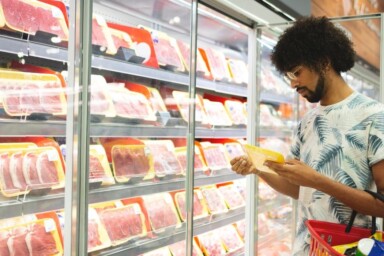We agree that exporting live animals for both fattening and slaughter should be phased out and that in principle we would welcome a ban. Now that the UK is no longer part of the EU, we are concerned that the UK will have no say in the enforcement and further development of welfare legislation and transport distances once lorries with live animals dock at EU ports. We believe there is no reason why all livestock should not be taken to slaughter weights within the UK and slaughtered here, with animals exported on the hook rather than the hoof. This would have animal welfare, environmental and financial benefits. Welfare because the animals will be spared a sea-crossing and will only have to endure shorter journeys; environmental, because carcases weigh only half as much as live animals, so fuel use and diesel emissions will be reduced significantly; financial because value will be added within the UK, with extra jobs created and more money kept within the British economy.
The UK should lead by example, but we recognise that the industry will need time to adjust and that, in particular, a review of slaughtering services should be carried out to identify where further services or capacity may be needed before a ban can be fully implemented.
In addition, we would like to see live exports for slaughter phased out between Great Britain and Northern Ireland and between Northern Ireland and Great Britain. We also feel that the Government should work with the devolved administrations to reduce (wherever practical) live transport involving long sea journeys from smaller British islands to mainland UK, through the provision of more local abattoirs.
The Government consultation also proposes changes to the maximum journey times that animals can travel within the UK. We recognise that there will sometimes be a need to transport animals longer distances within the UK for breeding or additional rearing, and we feel this can be justified on the basis that the animals will have time to recover and because farmers will have an added incentive to ensure the animals arrive in good condition. However, we believe that proposed maximum journeys of up to 18 hours for pigs and 21 hours for cattle and sheep are far too long for journeys to slaughter. The Government has led people to believe that it supports the slaughtering of animals as close to the point of production as possible and the British public would not expect this to mean journeys of anything like the times proposed.
Providing adequate abattoir services are made available across the UK, there is no reason why the vast majority of journeys specifically to slaughter should not be limited to four hours from point of departure. A phase-in period of up to five years would allow the critical issue of abattoir provision to be addressed. Exceptions might still be needed in relation to islands and remote areas, but the objective should be to minimise unnecessarily long journeys, that are currently being carried out purely for the convenience of supermarkets, not to make life impossible for farmers.
The decline of local abattoirs across the UK has been the focus of our campaign for the past three years. The Farm Animal Welfare Committee report, upon which much of this consultation is based, recommended ‘a review of the availability of abattoirs related to the points of production and particularly mindful of end of life requirement.’ The review also added that, ‘This will identify where abattoirs need to be sited in order to meet the needs of farmers and to minimise journey times and thereby meet the welfare needs of animals.’
FAWC also recommended further research into the ‘feasibility of the economics, design and use of mobile slaughter facilities so as to reduce the need to transport animals over long distances particularly with regard to sea crossings.’
We urge the Government to follow these recommendations and to ensure adequate provision is made for farmers to slaughter livestock within the UK without having to travel long distances. To make that possible, support will need to be given for new abattoirs to be established and for existing abattoir infrastructure to be improved where necessary.
An increasing number of farmers see local abattoirs and selling direct to consumers as an alternative route to market with the potential to increase farm incomes at a time when overall support for food production is expected to fall significantly. With rising demand for meat from farm shops, farmers’ markets and other local outlets, there will be further opportunities for some farmers to add value in this way, providing there is adequate local slaughtering capacity. However, this is no longer the case in many localities, with some farmers facing delays of many weeks and sometimes months before they can get animals slaughtered to meet demand from their customers.
We see addressing supermarkets and their desire to have total control of abattoirs that slaughter for them as central to the success of any meaningful policy to reduce distance to slaughter. Cattle and sheep, in particular, are often not slaughtered at the nearest suitable slaughterhouse but many miles further away at one owned, run or controlled by a particular supermarket. However, there is no reason why several supermarkets could not have animals slaughtered at the same slaughterhouse and indeed there are some examples where that already happens. This would require a policy mechanism to increase cooperation, and a 4 hour limit on journey times would help to provide this.
To read our full consultation response, click here.
To find out more about our work on livestock, abattoirs and animal welfare contact megan@sustainablefoodtrust.org
If you would like to make a donation to support our work in this area, please find out more here.
Photograph: Lesley







